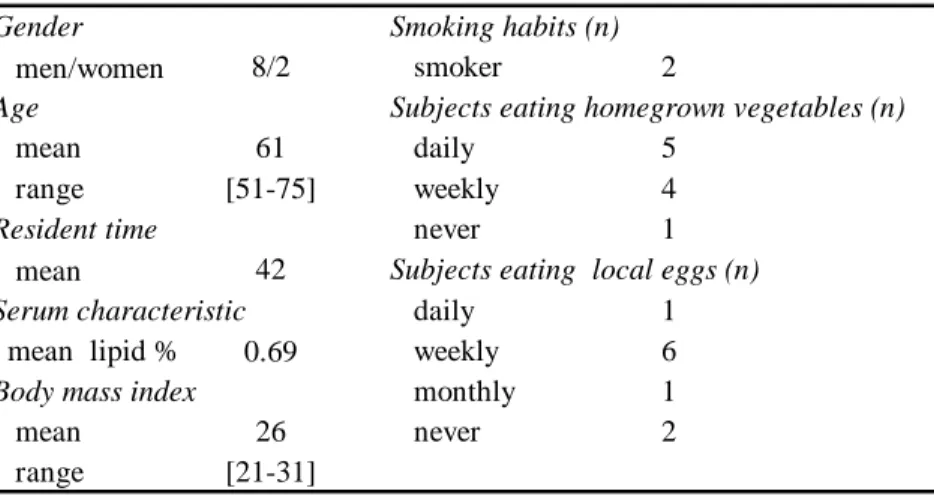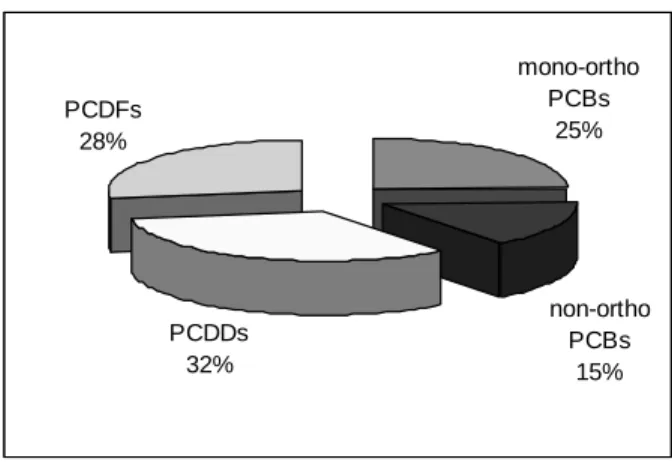BODY BURDENS AND DIETARY INTAKE
ASSESSMENT OF THE IMPACT OF AN OLD MSWI.
PART 2: LEVEL OF PCDD/Fs AND PCBs IN SERUM OF
PEOPLE LIVING IN ITS VICINITY
Catherine Pirard1, Jean-François Focant1, Anne-Cecile Massart1, Gauthier Eppe1, Edwin De Pauw1
1
Mass Spectrometry Laboratory, University of Liege
ORGANOHALOGEN COMPOUNDS – Volume 66 (2004) 2653
Introduction
For biomonitoring purposes, levels of Dioxin and PCB in human serum have been extensively measured all over the world, mostly in Asia or United State, but also in Europe such as in Germany, United Kingdom, Spain or in the Nordic Countries. These studies have been carried out either on general population in order to draw background level, or on exposed people to assess health risk or to highlight dioxin source emissions. This study reports dioxin and PCB concentrations in serum from people living in the surrounding of an old municipal solid waste incinerator (MSWI) recently closed because of very high dioxin emission rates.
Methods and Materials
Blood samples (100mL) from ten volunteers living for at least 25 years within 2km around the Vaux-le-Pénil incinerator (Maincy, France) were collected between February and April 2003. The participants consisted of 2 females and 8 males, and were 51 to 75 years old. They were asked to complete a questionnaire which included data on age, size, body weight and important weight loss, smoking habit, frequency of consumption of eggs from locally raised chicken and of vegetables grown in their own garden. Some of these informations are gathered in Table 1. Serum were separated by centrifugation and stored at –20°C until analysis was conducted.
Chemicals, standard solutions and detailed analytical method have already been extensively described previously1, 2. Briefly, serum samples added to formic acid and water were extracted by Solid Phase Extraction (SPE) using hexane to elute organic compounds from the C18. Further cleanup of all extracts was carried out using the automated Power-PrepTM (FMS Inc., Waltham, MA, USA) system using acidic silica, basic alumina and PX-21 carbon columns. Measurements of PCDD/Fs and PCBs were described in Part 1 abstract.
BODY BURDENS AND DIETARY INTAKE
ORGANOHALOGEN COMPOUNDS – Volume 66 (2004) 2654
Table 1. Characteristics of sites selected
Gender Smoking habits (n)
men/women 8/2 smoker 2
Age Subjects eating homegrown vegetables (n)
mean 61 daily 5
range [51-75] weekly 4
Resident time never 1
mean 42 Subjects eating local eggs (n)
Serum characteristic daily 1
mean lipid % 0.69 weekly 6
Body mass index monthly 1
mean 26 never 2
range [21-31]
Results and Discussion
Despite the small cohort size of this case study, a relatively good homogeneity was observed regarding age and dietary habits. Table 2 shows concentrations of PCBs (non-ortho, mono-ortho and congeners of A1260) and PCDD/Fs in collected serum specimen.
PCB levels in serum from Maincy's inhabitants were 1.5 to 2 fold higher than those found in western European population3-7, but still lower than levels reported for high Baltic Sea fish consumers8, 9. Because of the mean age of the cohort was relatively high, higher persistent pollutant levels were expected compared to general population. Nevertheless, residents from Maincy had PCB serum concentrations twice higher than the one recently reported for Belgian women aged between 50 and 55 years6. The pattern was similar to those consistently detected in human tissue worldwide10, dominated by PCB-180, -153 and -138. PCDD/F pattern was characterized by predominance of OCDD and to a lower extent by HpCDD and 1,2,3,7,8,9-HxCDF. It is similar to the one that is commonly found, but levels were more than twice higher than for the average European population7, 11-14 (11 and 27 pgTEQ/g lipid).
Table 2. Sum of PCBs and PCDD/Fs expressed in pgTEQ/g lipid.
Mean Median Range
PCBs A1260* 616,2 586,7 [377-656] mono-ortho 19,2 17,9 [14.8-29.0] non-ortho 11,5 10,1 [3.5-27.2] PCDD/Fs Dioxins 25,1 23,5 [18.0-38.0] Furans 21,6 20,0 [16.5-32.7] Total 47,3 43,0 [37.1-65.2] Total TEQ 76,1 74,6 [59.8-86.6] * Concentration in ng/g
BODY BURDENS AND DIETARY INTAKE
ORGANOHALOGEN COMPOUNDS – Volume 66 (2004) 2655
Even when compared to similarly aged population, PCDD/F serum levels exceeded the 20 pgTEQ/g lipid estimated for a 60 years old Spanish population7, 12. Contributions of PCDDs, PCDFs, non- and mono-ortho PCBs to the total TEQ are represented on Figure 1. This repartition was comparable to what usually found in literature3.
Figure 1. Total TEQ contribution
PCDFs 28% PCDDs 32% mono-ortho PCBs 25% non-ortho PCBs 15%
To our knowledge, available data about dioxin body burden in France are scarce. A 19.6 pgTEQ/g lipid dioxin level has been estimated by Fréry et al.15 in breast milk of French women. Although human milk reflects blood lipid level in term of dioxin on a lipid weight basis, the age factor did not allow simple comparison between our both studies. Arfi et al.17 has reported mean concentration of 35.6 pgTEQ/g lipid in adipose tissue of a non-occupationally exposed French cohort with mean age of 55 years old.
European surveys on populations residing in the vicinity of incinerator have never demonstrated any significant rise of dioxin blood concentration so far7, 18, 19. The concerned facilities had dioxin emissions ranging between 2-3 ngTEQ/m³, far below the 226 ngTEQ/m³ value recorded for Vaux-le-Pénil MSWI. Comparing with the Belgian neighbouring country where industrialised activities and dietary habits are roughly the same, Fierens et al.13 have observed for an average of 53 years old population living near MSWI releasing more than 50 ngTEQ/m³, a dioxin blood level 38 pgTEQ/g lipid. This situation is close to ours regarding age bracket, polluting MSWI, but also because Fierens's results were referring to people living in a rural area where dietary habits are characterised by high consumption of locally produced animal foodstuffs such as milk or dairy by-products and chicken eggs. Most of blood donors from Maincy have also reported to eat vegetables and eggs from their own poultry or from neighbours up to once a day to once a week. In spite of all these similarities, Maincy subjects show higher median serum concentration either for PCDD/Fs or for coplanar PCBs even if concentration of all French subjects remains in the range reported by Fierens13.
Conclusion
Residents of Maincy showed markedly higher levels of PCDD/Fs and PCBs than usual European background, although remaining in the range reported. These levels are higher than Belgian population living around MSWI releasing more than 50 ngTEQ/m³, and consuming locally
BODY BURDENS AND DIETARY INTAKE
ORGANOHALOGEN COMPOUNDS – Volume 66 (2004) 2656
produced animal products. Our results, where MSWI increased PCDD/F level in environment and consequently in locally home-produced food products, was in agreement with Domingo et al.20 who have assumed that dioxin exposure for a population residing in the vicinity of MSWI would be unlikely due to its emission but mainly to general dietary intake.
Acknowledgements
This research was supported by the University of Liège and the "C.A.R.T.". References
1. Focant J.-F. and De Pauw E. (2001) J. Chromatogr. B 776, 199.
2. Pirard C., Focant J.-F. and De Pauw E. (2002) Anal. Bioanal. Chem. 372, 373.
3. Fürst P. and Päpke O. (2002) Organohalogen Compds 55, 251.
4. Schwenk M., Gabrio T., Päpke O. and Wallenhorst T. (2002). Chemosphere 47, 229.
5. Koppen G., Covaci A., Van Cleuvenbergen R., Schepens P., Winneke G., Nelen V., van Larebeke N., Vlietinck R. and Schoeters, G. (2002) Chemosphere 48, 811.
6. Voorspoels S., Covaci A., Maervoet J. and Schepens P. (2002) Bull. Environ. Contam. Toxicol. 69, 22.
7. Gonzalez C. A., Kogevinas M., Gadea E., Huici A., Bosch A., Bleda M. J. and Päpke O. (2000) Arch. Environ. Health 55, 259.
8. Asplund L., Svensson B.-G., Nilsson A., Eriksson U., Jansson B., Jensen S., Wideqvist U. and Skerfving S. (1994) Arch. Environ. Health 49, 477-486.
9. WingforsH., LindstromG., Van Bavel B., Schuhmacher M. and Hardell L. (2000) Chemosphere 40, 1083.
10. Humphrey H. E., Gardiner J. C., Pandya J. R., Sweeney A. M., Gasior D. M., McCaffrey R. J. and Schantz S. L. (2000) Environ Health Perspect 108, 167.
11. Wittsiepe J., Schrey P., Ewers U., Selenka F. and Wilhelm M. (2000) Chemosphere 40, 1103.
12. Jimenez B., Hernandez L. M., Eljarrat E., Rivera J. and Gonzalez M. J. (1996) Chemosphere 33, 2403.
13. Fierens S., Mairesse H., Hermans C., Bernard A., Eppe G., Focant J.-F. and De Pauw E. (2003) J. Toxicol. Environ. Health Part A 66, 1287.
14. Johansen H. R., Alexander J., Rossland O. J., Planting S., Lovik M., Gaarder P. I., Gdynia W., Bjerve K. S. and Becher G. (1996) Environ. Health Perspect. 104, 756.
15. Fréry N., Deloraine A., Dor F., Zeghnoun A. and Rouvière F. (2000) Organohalogen Compds 48, 47.
16. Aylward L. L., Hays S. M., LaKind J. S. and Ryan J. J. (2003).J Toxicol Environ Health A 66, 1.
17. Arfi C., Seta N., Fraisse D., Revel A., Escande J.-P. and Momas, I. (2001) Chemosphere 44, 1347.
18. Deml E., Mangelsdorf I. and Greim H. (1996) Chemosphere 33, 1941.
19. SchuhmacherM., DomingoJL., LlobetJM., LindstromG.andWingforsH. (1999)Chemosphere38, 1123.
20. Domingo J. L., Agramunt M. C., Nadal M., Schuhmacher M. and Corbella, J. (2002) Arch. Environ. Contam. Toxicol. 43, 461.

